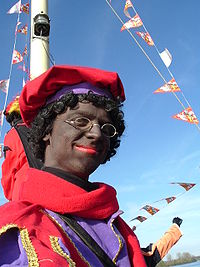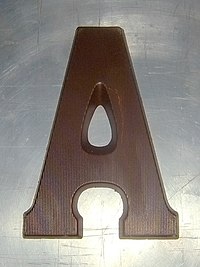Sinterklaas
This article possibly contains original research. (September 2007) |
Sinterklaas (also called Sint Nikolaas in Dutch () and Saint Nicolas in French) is a holiday tradition in the Netherlands and Belgium, celebrated every year on Saint Nicholas' eve (December 5) or, in Belgium, on the morning of December 6. The feast celebrates the name day of Saint Nicholas, patron saint of children.
It is also celebrated to a lesser extent in parts of France (North, Alsace, Lorraine), as well as in Luxembourg, Switzerland, Germany, Austria, Poland, Romania and the Czech Republic. The traditions differ from country to country, even between Belgium and the Netherlands.
In the Netherlands, Saint Nicholas' Eve, (December 5) is the chief occasion for gift-giving. The evening is called pakjesavond ("presents' evening"). Traditionally, presents are ingeniously wrapped, and are therefore called surprises. Also, presents are traditionally accompanied by a poem from Saint Nicholas.
Sinterklaas is the basis for the North American figure of Santa Claus; the Dutch colonial town of New Amsterdam maintained a Sinterklaas tradition, long after it was occupied by the English and renamed New York City. The name Santa Claus is derived from older Dutch Sinte Klaas.
Sinterklaas






Template:FixBunching The Sinterklaas feast celebrates the name day of Saint Nicholas (280-342), patron saint of children. Saint Nicholas was bishop of Myra in present-day Turkey and became the patron saint of children based on various legends that include resurrecting children from death and saving them from prostitution.
Sinterklaas has a long white beard, wears a red bishop's dress and red mitre (bishop's hat), and holds a crosier, a long gold coloured staff with a fancy curled top. Sinterklaas carries a big book with all the children's names in it, which states whether they have been good or naughty (zoet of stout) in the past year.
He also rides a white horse called Amerigo over the rooftops. In Belgium, the horse's name is "Slechtweervandaag", meaning "Bad Weather Today".[citation needed] The story told to children in Belgium is that Sinterklaas had just gotten the horse, and couldn't think of a name. When Zwarte Piet entered Sinterklaas' winter castle, Sinterklaas immediately asked if Zwarte Piet knew a name. Not having heard the question, Zwarte Piet said "Slecht Weer Vandaag", commenting on the weather. Sinterklaas thought Zwarte Piet was actually naming the horse, and the name stuck.
Zwarte Piet
Sinterklaas is assisted by many mischievous helpers with black faces and colourful outfits, modelled after 16th century Spanish clothing. These helpers are called Zwarte Pieten (Black Petes) in Dutch (see below for names in other languages). During the Middle Ages, Zwarte Piet was a name for the devil. Having triumphed over evil, it was said that on Saint Nicholas' eve, the devil was shackled and made his slave. Although the character of Black Pete later came to acquire racial connotations, his origins were in the devil figure.[citation needed] This racialisation is reflected in the reworking of the characters' mythos. From about 1850, Pete was said to be an imported African servant of Saint Nicholas. Today however, a more politically correct explanation is given: Pete's face is said to be "black from soot" (as Pete has to climb down chimneys to deliver his gifts). Nevertheless, the tradition has been accused of being racist, and attempts have been made to introduce Gekleurde Pieten (Coloured Petes), who are coloured blue, red, etc., instead of black. This phenomenon of "Coloured Petes" was introduced nationally in 2006 in the Sinterklaasjournaal (a television newsbulletin for 'believing' children about Sinterklaas, which runs from the end of November until December 5). The explanation given for this was that "Sinterklaas passed through a rainbow with his boat".[1] The real explanation must be found in the two ravens that Wodan had as friend. Before the church claimd the saint the date was already known as the namedate of Wodan. His two black ravens had transformed into the black petes.
Traditionally Saint Nicholas only had one helper, whose name varied wildly. "Piet" or "Pieter", the name in use now, can be traced back to a book from 1891[2]. The idea that Sinterklaas has not one but many helpers was introduced by Canadian soldiers who had liberated the Netherlands during World War II and helped organise the first post-war Sinterklaas celebration.[citation needed]
In other regions where Sinterklaas is celebrated, like southern Belgium or Northern France, Saint Nicholas has different companions.
Arrival
Sinterklaas traditionally arrives each year in November by steamboat from Spain, and is then paraded through the streets, welcomed by cheering and singing children. Invariably, this event is broadcast live on national television in the Netherlands and Belgium. His Zwarte Piet helpers throw candy and small, round ginger bread-like cookies, kruidnoten or pepernoten, into the crowd. The children welcome him by singing traditional Sinterklaas songs. Sinterklaas also visits schools, hospitals and shopping centres. After this arrival all towns with a dock have their own intocht van Sinterklaas (arrival of Sinterklaas)
Shoe
Traditionally, in the weeks between his arrival and the 5th of December, before going to bed, children put their shoes next to the chimney of the coal fired stove or fireplace, with a carrot or some hay in it "for Sinterklaas's horse", sing a Sinterklaas song, and will find some candy in their shoes the next day, supposedly thrown down the chimney by a Zwarte Piet or Sinterklaas himself. However, with the advent of central heating children put their shoes near the boiler or even just next to the front door.
Typical Sinterklaas candy is the first letter of the child's name made out of chocolate, chocolate coins, a figurine of Sinterklaas made out of chocolate and wrapped in painted aluminium foil, and coloured marzipan shaped into fruit, an animal or some other object.
Children are told that Black Pete enters the house through the chimney, which also explains his black face and hands, and would leave a bundle of sticks (roe) or a small bag with salt in the shoe instead of candy when the child had been bad.
Children are also told that in the worst case they would be put in the gunny sack in which Black Pete carries the presents, and be taken back to Spain, where Sinterklaas is said to spend the rest of the year. This practice however has been condemned by Sinterklaas in his more recent television appearances as something of the past. Typical of that time was also the fact that the saint would have the names of every child written down in either his "golden book" (if a child had been good), or his "black book" (if a child had been bad) - very much like the Wodan's ravens reporting everything in the world to him. The standard joke would be that initially Sinterklaas would not be able to find the name in the "golden book", trying to scare the children. With modern views on child psychology, these practises have been abandoned as well.
Pakjesavond
Traditionally Saint Nicholas brings his gifts at night, and Belgian children still find their presents on the morning of December 6th. Later in The Netherlands adults started to give each other presents on the evening of the 5th; then older children were included and today in that country even the youngest on the evening of December 5 (Saint Nicholas' eve), known as Sinterklaasavond or Pakjesavond (present evening). There will be a loud knock on the door, and a sack full of presents is found on the doorstep. Alternatively - some improvisation is often called for - the parents 'hear a sound coming from the attic' and then the bag with presents is "found" there. Some parents manage to "convince" Sinterklaas to come to their home personally.
Presents are often accompanied by a simple poem, saying something about the child or with a hint to the nature of the present.
When the presents are too bulky in size or when the quantity of presents is too large, they have to be snuck into the house while the kids are distracted.
Sinterklaas in other countries
| country | saint | helper | tradition |
|---|---|---|---|
| The Netherlands | Sinterklaas, de Sint | Zwarte Piet | see above |
| Flanders (Belgium) | Sinterklaas, de Sint | Zwarte Piet | see above |
| Wallonie (Belgium) | Saint Nicolas | Père Fouettard | |
| Luxembourg | Kleeschen | Houseker | comes from heaven, not from Spain |
| Alsace (France) | Saint Nicolas | Hanstrapp or Rupelz | |
| Lorraine (France) | Saint Nicolas | Père Fouettard | |
| Germany | Nikolaus | Knecht Ruprecht | comes from heaven on a sledge |
| Austria | Krampu or Schab | ||
| Switzerland | Samichlaus | Schmutzli | comes from the Black Forest (Schwarzwald) |
| Poland | Święty Mikołaj | ||
| Romania | Moṣ Nicolae | ||
| Hungary | Mikulás | Krampusz |
